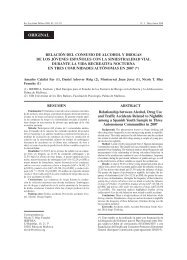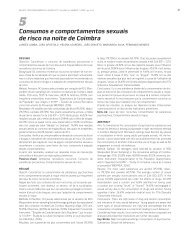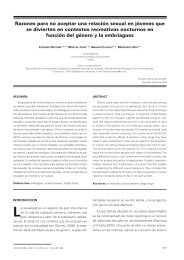Characteristics and social representation of ecstasy in Europe - Irefrea
Characteristics and social representation of ecstasy in Europe - Irefrea
Characteristics and social representation of ecstasy in Europe - Irefrea
You also want an ePaper? Increase the reach of your titles
YUMPU automatically turns print PDFs into web optimized ePapers that Google loves.
underst<strong>and</strong><strong>in</strong>g <strong>and</strong> expla<strong>in</strong><strong>in</strong>g reality, identification, orientation <strong>of</strong> behaviours <strong>and</strong>justification <strong>of</strong> such behaviours. In the words <strong>of</strong> Abric, “the functions <strong>of</strong> <strong>social</strong><strong>representation</strong> are essential for the underst<strong>and</strong><strong>in</strong>g <strong>of</strong> <strong>social</strong> dynamics... It is <strong>in</strong> the orig<strong>in</strong><strong>of</strong> <strong>social</strong> practices from those functions that fabricate a common sense, or <strong>social</strong>identity, from the expectations <strong>and</strong> anticipations which is generated” (Abric, 1994). Onthe other h<strong>and</strong>, as we mentioned earlier, it is also <strong>in</strong>terest<strong>in</strong>g as a theory which comb<strong>in</strong>esobjective <strong>social</strong> phenomena <strong>and</strong> the cognitive processes, to take <strong>in</strong>to account bothsociety as a whole <strong>and</strong> the <strong>in</strong>dividual <strong>in</strong> particular.. To quote Verges, “<strong>in</strong> effect, itenables consideration, at a particular time <strong>of</strong> collective determ<strong>in</strong>ations, on the one h<strong>and</strong>,<strong>and</strong> freedom <strong>of</strong> choice <strong>and</strong> the creation <strong>of</strong> the <strong>social</strong> actor, on the other” (Verges, 1996).The group <strong>of</strong> <strong>social</strong> psychologists <strong>in</strong> Aix-en-Provence (Abric, Flament, Verges...)reached the conclusion that <strong>social</strong> <strong>representation</strong> is a double system compris<strong>in</strong>g:A central system (central nucleus) “whose determ<strong>in</strong>ation is essentially <strong>social</strong>, l<strong>in</strong>ked tohistorical, sociological <strong>and</strong> ideological conditions <strong>and</strong> therefore, directly associated withvalues <strong>and</strong> norms” (Abric, 1994). This nucleus is the responsible <strong>of</strong> the stability <strong>of</strong> the <strong>of</strong>the <strong>representation</strong>, so that it rema<strong>in</strong>s through time. This system changes, but very slowly.A peripheral system, that depends on <strong>in</strong>dividual characteristics <strong>and</strong> on the dailycircumstances.Therefore, for a complete knowledge <strong>of</strong> <strong>social</strong> <strong>representation</strong> from the po<strong>in</strong>t <strong>of</strong> view<strong>of</strong> the theory <strong>of</strong> <strong>representation</strong>, which these authors are defend<strong>in</strong>g, one has todist<strong>in</strong>guish between the components that comprise each system.One <strong>of</strong> the sectors <strong>in</strong> which there has been a great deal <strong>of</strong> work on the theory <strong>of</strong><strong>social</strong> <strong>representation</strong> is <strong>in</strong> the field <strong>of</strong> health. One <strong>of</strong> the pioneer <strong>and</strong> l<strong>and</strong>mark studieson this theory is the work by Jodelet on the <strong>social</strong> <strong>representation</strong> <strong>of</strong> <strong>in</strong>sanity (Jodelet,1984). Other titles with<strong>in</strong> this same field are “Réprésentations <strong>social</strong>es et image de lapsychiatrie” by Penochet <strong>and</strong> Guimelli (1994), “La fonction d’<strong>in</strong>fermiére”, also byGuimelli <strong>and</strong> which appeared, together with other studies, <strong>in</strong> “Pratiques <strong>social</strong>es etreprésentation” (Abric, 1994) etc.At the present time, analysis <strong>of</strong> <strong>social</strong> <strong>representation</strong> is be<strong>in</strong>g carried out on matterswhich are important <strong>social</strong> problems <strong>and</strong> where the preventive strategies put <strong>in</strong>topractice to date, have not achieved the expected results. It <strong>in</strong>volves f<strong>in</strong>d<strong>in</strong>g anexplanation for these preventive failures <strong>and</strong> underst<strong>and</strong><strong>in</strong>g these problems from theperspective <strong>of</strong> the different <strong>social</strong> groups.One <strong>of</strong> these problems is AIDS, where several studies have already been made,notably two works by Michel Mor<strong>in</strong>, one <strong>in</strong> which the author endeavours to show thedifferent attitudes <strong>and</strong> behaviours <strong>of</strong> doctors deal<strong>in</strong>g with Aids patients, where it isconsidered <strong>of</strong> great importance that doctors are more <strong>in</strong>volved <strong>in</strong> the prevention <strong>and</strong>care <strong>of</strong> patients (Mor<strong>in</strong> et al. 1996), <strong>and</strong> a second, <strong>in</strong>cluded <strong>in</strong> the book “The SocialChallenge <strong>of</strong> AIDS” (Basabe et al. 1996) <strong>in</strong> which, us<strong>in</strong>g the theory <strong>of</strong> <strong>social</strong><strong>representation</strong>, he discusses the hypothesis <strong>of</strong> ignorance <strong>and</strong> resistance to change as anexplanation for the advance <strong>of</strong> this illness.96













